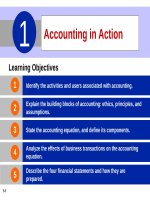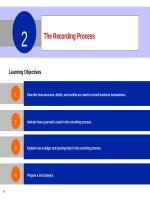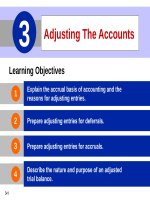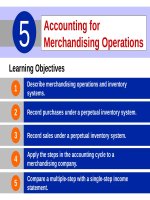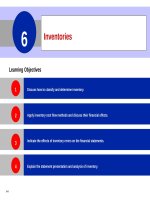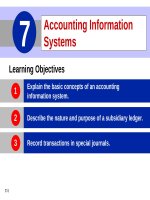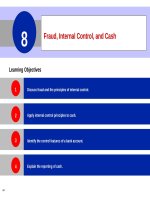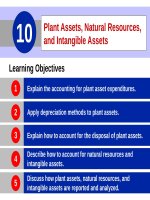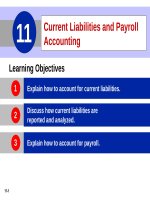Accounting principles 10e by kieso chapter 20
Bạn đang xem bản rút gọn của tài liệu. Xem và tải ngay bản đầy đủ của tài liệu tại đây (1.92 MB, 57 trang )
20-1
CHAPTER20
Job Order
Costing
20-2
PreviewofCHAPTER20
20-3
Cost Accounting Systems
Cost accounting involves the measuring, recording,
and reporting of product costs.
Important feature is the use of a perpetual inventory
system.
Two basic types of cost accounting systems:
1. a job order cost system and
2. a process cost system.
20-4
SO 1 Explain the characteristics and purposes of cost accounting.
Cost Accounting Systems
Job Order Cost System
20-5
Costs are assigned to each job or batch.
Job may be for a specific order or inventory.
Each job or batch has its own distinguishing
characteristics.
Objective is to compute the cost per job.
Measures costs for each job completed – not for set time
periods.
SO 1 Explain the characteristics and purposes of cost accounting.
Cost Accounting Systems
Job Order Cost System
Illustration 20-1
20-6
SO 1 Explain the characteristics and purposes of cost accounting.
Cost Accounting Systems
Process Cost System
20-7
Used when a large volume of similar products are
manufactured - Cereal, Automobiles, Compact Discs,
Paint.
Costs are accumulated for a specific time period.
Costs are assigned to departments or processes for a
set period of time.
SO 1 Explain the characteristics and purposes of cost accounting.
Cost Accounting Systems
Process Cost System
Illustration 20-2
20-8
SO 1 Explain the characteristics and purposes of cost accounting.
Cost Accounting Systems
Question
Cost accounting involves the measuring, recording, and
reporting of:
a. Product costs.
b. Future costs.
c. Manufacturing processes.
d. Managerial accounting decisions.
20-9
SO 1 Explain the characteristics and purposes of cost accounting.
20-10
Job Order Cost Flow
Cost flow parallels the physical flow of the materials as
they are converted into finished goods.
20-11
Manufacturing costs are assigned to Work in Process.
Cost of completed jobs is transferred to Finished Goods.
When units are sold, the cost is transferred to Cost of
Goods Sold.
SO 2 Describe the flow of costs in a job order cost accounting system.
Job Order Cost Flow
Illustration 20-3
Flow of costs in job
order costing
20-12
SO 2 Describe the flow of costs in a job order cost accounting system.
Job Order Cost Flow
20-13
Illustration 20-4
Job order costing system
SO 2
Job Order Cost Flow
Two Major Steps in Flow of Costs
20-14
Accumulate the manufacturing costs incurred.
►
Raw Materials
►
Factory Labor
►
Manufacturing Overhead
Assign the accumulated costs to the work done.
SO 2 Describe the flow of costs in a job order cost accounting system.
Job Order Cost Flow
Accumulating Manufacturing Costs
Raw Materials Costs
20-15
Raw materials purchased are debited to Raw Materials
Inventory.
Debit this account for invoice cost of raw materials and
freight costs chargeable to purchaser.
Credit this account for purchase discounts taken and
purchase returns and allowances.
SO 2 Describe the flow of costs in a job order cost accounting system.
Accumulating Manufacturing Costs
Illustration: Wallace Manufacturing purchases 2,000 handles
(Stock No. AA2746) at $5 per unit ($10,000) and 800 modules
(Stock No. AA2850) at $40 per unit ($32,000) for a total cost of
$42,000 ($10,000 + $32,000). The entry to record this purchase
on January 4 is:
Jan. 4
Raw Materials Inventory
Accounts Payable
20-16
42,000
42,000
SO 2 Describe the flow of costs in a job order cost accounting system.
Job Order Cost Flow
Factory Labor Costs
Debit labor costs to Factory Labor as costs are incurred.
Consists of:
1) Gross earnings of factory workers,
2) Employer payroll taxes on such earnings, and
3) Fringe benefits incurred by the employer.
20-17
SO 2 Describe the flow of costs in a job order cost accounting system.
Job Order Cost Flow
Illustration: Wallace Manufacturing incurs $32,000 of factory
labor costs. Of that amount, $27,000 relates to wages payable
and $5,000 relates to payroll taxes payable in January. The entry
to record factory labor for the month is:
Jan. 31
Factory Labor
32,000
Factory Wages Payable
Employer Payroll Taxes Payable
20-18
27,000
5,000
SO 2 Describe the flow of costs in a job order cost accounting system.
Job Order Cost Flow
Manufacturing Overhead Costs
20-19
Company may
►
recognize these costs daily, or,
►
periodically through adjusting entries.
Companies record property taxes, depreciation, and
insurance periodically.
SO 2 Describe the flow of costs in a job order cost accounting system.
Job Order Cost Flow
Illustration: Using assumed data, the summary entry for
manufacturing overhead in Wallace Manufacturing Company is:
Jan. 31
20-20
Manufacturing Overhead
13,800
Utilities Payable
4,800
Prepaid Insurance
2,000
Accounts Payable (for repairs)
2,600
Accumulated Depreciation
3,000
Property Taxes Payable
1,400
SO 2 Describe the flow of costs in a job order cost accounting system.
Job Order Cost Flow
Question
When incurred, factory labor costs are debited to
20-21
a.
Work in Process.
b.
Factory Wages Expense.
c.
Factory Labor.
d.
Factory Wages Payable.
SO 2 Describe the flow of costs in a job order cost accounting system.
Job Order Cost Flow
Assigning Manufacturing Costs to Work in
Process
Manufacturing costs are assigned to Work in Process with
Debits to
Work in Process Inventory
Credits to
Raw Materials Inventory
Factory Labor
Manufacturing Overhead
20-22
Entries are usually made monthly.
Essential accounting record is a job cost sheet.
SO 3 Explain the nature and importance of a job cost sheet.
Assigning Manufacturing Costs to WIP
Job Cost Sheet
20-23
Used to record costs of a specific job.
Used to determine total and unit costs of a completed job.
Postings are made daily.
Each entry to a Work in Process Inventory must be
accompanied by a corresponding posting to one or more
job cost sheets.
SO 3 Explain the nature and importance of a job cost sheet.
Assigning Manufacturing Costs to WIP
Illustration 20-5
20-24
SO 3 Explain the nature and importance of a job cost sheet.
Assigning Manufacturing Costs to WIP
Raw Materials Costs
20-25
Companies assign raw materials costs when their
materials storeroom issues the materials.
Materials requisition slip:
►
Should indicate quantity and type of materials
withdrawn and account to be charged.
►
Direct materials are charged to WIP Inventory, and
indirect materials to Manufacturing Overhead.
SO 3 Explain the nature and importance of a job cost sheet.

